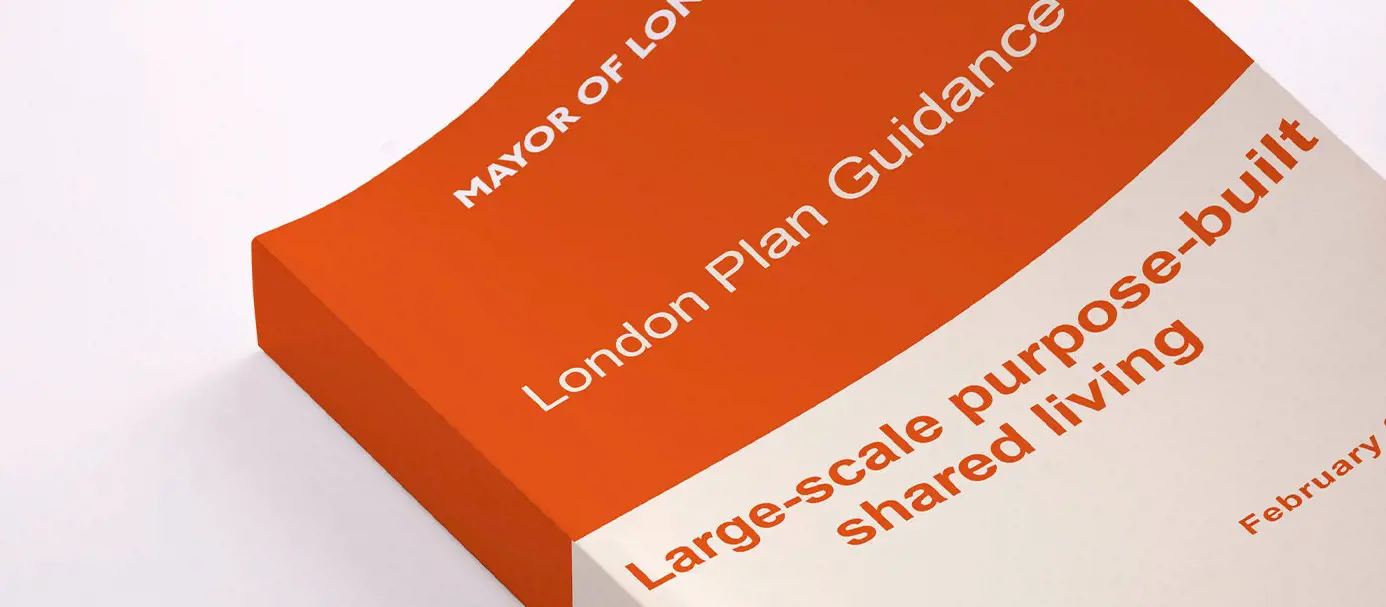Lichfields' initial view on the GLA’s new Large-scale purpose-built shared living London Plan Guidance February 2024
For those of us working in the co-living sector, Thursday 29
th February not only stood out as being a ‘leap-day’ but also as the date on which the GLA published the
Large-scale purpose-built shared living London Plan Guidance for adoption.
Following the publication of the first draft in January 2022, the document has been long awaited and, for what is a relatively new form of residential in the UK, a lot has happened in the co-living sector in the meantime. The last two years have seen a significant increase in the number of schemes being opened and many more are in the planning pipeline to deliver the ‘second-generation’ of co-living developments.
So does the new guidance represent a leap forward for co-living?
Well, to take a slight step back, it is fair to say that the draft guidance was met with some concern from co-living developers and operators. It was not necessarily supported by the evidential data which has become available in the last two years and did not apply the degree of flexibility necessary for a new, frequently innovative, form of residential living.
Having worked collaboratively with the industry in the intervening period, including many of the major co-living developers such as Halcyon, the Second Generation Shared Living Consortium and Local Authorities, the GLA has produced a document which goes a long way to meeting these concerns. We are pleased to see that many of the issues raised in relation to the previous document have been addressed and the Guidance now provides a robust and suitably flexible framework which will support the delivery of many of the co-living schemes Lichfields is working on and many others across the capital.
As with the original draft, the document is quite detailed in places and there is a lot to consider in the design and development of schemes. We have pulled out what we consider to be some of the LPG’s most significant points, and provide Lichfields’ perspective on the practical application of the guidance.
Locational Requirements
-
London Plan Policy H16 encourages co-living in areas “well-connected to local services". The guidance helpfully expands on this and specifically identifies which areas will be more suitable for co-living, including the CAZ and Inner London Opportunity Areas, Metropolitan and Major town centres, all areas with a PTAL of 5 or 6 and Inner London areas with a PTAL of 4, and other town centres with high or medium growth potential. These are all areas where we have seen an increase in demand for co-living developments and the guidance firmly supports the delivery of schemes in these areas.
Housing Need
-
When submitting planning applications for co-living schemes, it is typical to demonstrate how the development will meet housing need. The LPG recognises that co-living can contribute an element of housing choice and contribute towards housing supply at a ratio of 1.8:1. It also provides more information around how co-living can contribute positively to well-designed, mixed and inclusive neighbourhoods and what should be considered when assessing these developments. The LPG’s approach to housing need is positive. It supports the principle of co-living development and provides clarity on the approach to assessing need and bringing forward schemes.
-
However, the Guidance goes on to advocate caution in the ‘clustering’ of co-living (relative to conventional housing) in certain locations and which could have a negative impact on creating mixed and inclusive neighbourhoods. Where this is the case, LPAs, with appropriate evidence, could introduce policies to restrict overconcentration of co-living, or in the absence of policy seek to limit clustering on a case by case basis.
-
We consider that whilst there may be challenges around the location of co-living developments in the preparation of Local Plans, the additional recognition of the benefits to neighbourhoods and local housing mix are positive. Equally, the introduction of a more standardised approach to assessing the impact of co-living in relation to housing needs will assist applicants and local authorities in the assessment of schemes. The Guidance reinforces the need for co-living developers to get involved at the plan making stage.
Space Standards
-
Critical to the success of the Guidance, and a key point made during the consultation on the initial draft, is the introduction of flexibility in the application of space and amenity standards. The Guidance states, “some flexibility in the assessment of LSPBSL applications against these recommended benchmarks may be applied to the design, scale and provision of these facilities in consideration of the site’s location and context, or other scheme-specific factors where it is demonstrated that qualitatively good design outcomes are being achieved.” It also allows for amenity space to be seen in the context of room sizes, so that where rooms are smaller, a higher quantum of communal space may be provided.
-
This flexibility is welcome as it avoids the ‘one size fits all’ approach which has often been applied in the past. Co-living schemes have the ability to develop a range of sites, in all locations and for differing markets. The ability to flex the design to respond to these changing factors is key.
-
Of particular note, the LPG’s communal space requirement has been reduced to reflect the economies of scale in larger developments. Schemes of up to 100 residents have a benchmark requirement of 4sqm per resident. However, schemes larger than 100 and 400 units require proportionately less communal space per additional resident - 3sqm and 2sqm per additional resident respectively.

Table 3.1 LSPSL LPG
Room Sizes
-
The minimum (18sqm) and maximum (27sqm) room sizes, and related accessible unit sizes, from the draft document have been retained in the adopted Guidance. Co-living schemes typically fall within this range. However, it is important to avoid the assumption that the larger the unit the better quality the accommodation. The 27sqm maximum is provided to prevent the units becoming marketed or used as self-contained housing as has been the case for some developments in London.
-
Of note and new to this version of the LPG is the recognition that some larger units may be suitable for occupation by couples.
External Space
-
The importance of external space is , quite rightly, emphasised in the LPG in recognition of the role in plays in wellbeing, urban greening and biodiversity. The provision of high quality external spaces, often in the form of terraces in the most desirable parts of the building, is something which co-living can provide in ways traditional residential accommodation may not. For example, a roof level terrace with views of London which is accessible to everyone in the building is a significant benefit which can be delivered in co-living schemes and this approach is supported by the Guidance.
Table 3.4 LSPSL LPG
Affordable Housing
-
London Plan Policy H16 requires co-living developments to make a payment in lieu contribution towards the provision of new C3 off-site affordable housing. However, in accordance with the Draft Affordable Housing Guidance published last year, the LPG now recognises that in some cases the on-site provision of C3 affordable housing could be acceptable. Increasingly, we are seeing Local Authorities encouraging the delivery of on-site affordable housing, where it is possible, as it is seen as a tangible planning benefit. Further guidance on this matter is expected.
Cycle Parking
-
The LPG adopts a bespoke approach to cycle parking, requiring 0.75sqm per person and importantly introducing flexibility which can be applied based on site location and where onsite shared bicycle schemes are provided. We are seeing the introduction of schemes with innovative cycle sharing facilities which can provide a range of cycle types for residents as part of their rent. The approach taken by the guidance will foster this innovation and allow schemes to respond to the requirements of tenants as well as location.
Inclusive Building Design
-
The LPG introduces additional guidance on the importance of ensuring that buildings are design to meet the needs of people with a range of disabilities and impairments. This goes beyond wheelchair access and includes mobility, sensory, dexterity and learning difficulties and how this can be addressed in design. The LPG’s recognition that co-living has an important role to play in providing homes for a wide and diverse population is a positive feature of the adopted document.
So in summary, the adopted LSPBSL Guidance represents a significant evolution from the previous draft. Many of the changes will be welcomed by the industry. This is particularly the case in terms of the LPG’s clear support for the principle of co-living in the right location, the clarity it provides on assessing housing need, its emphasis on a design-led approach, the more appropriate and better-evidenced standards it sets and the inherent flexibility encouraged in the application of those standards.

It is clear to Lichfields that well designed and appropriately located co-living developments have a central role to play in meeting London’s pressing housing need, diversifying the capital’s housing stock and strengthening its communities. The planning system must foster and facilitate these developments. We are encouraged to see that the GLA’s LPG firmly recognises these opportunities and provides a logical and flexible framework to support the delivery of co-living schemes. It will be interesting to see how the market responds
So the leap-day did indeed produce a leap forward for London’s co-living sector.






